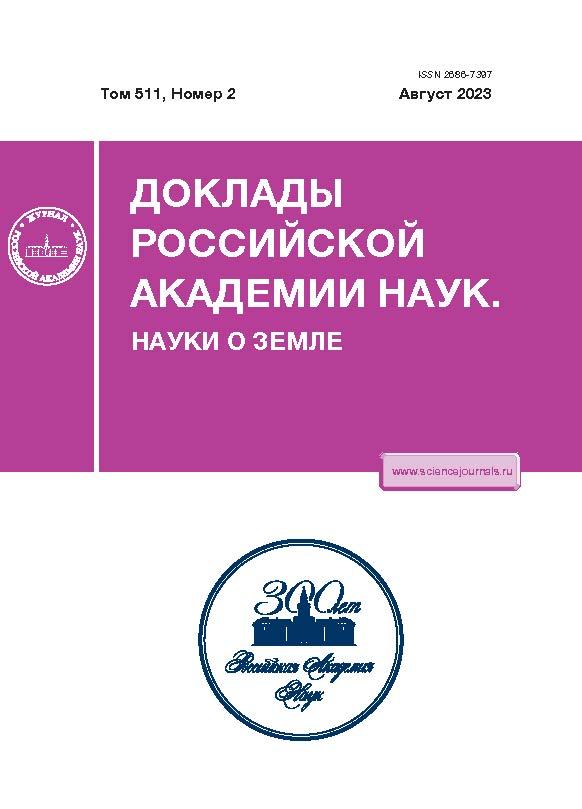KAHRAMANMARASH EARTHQUAKES IN TURKEY: SEISMIC MOTION ALONG CONJUGATED FAULTS
- Authors: Tikhotsky S.A.1, Tatevosyan R.E.1, Rebetsky Y.L.1, Ovsyuchenko A.N.1, Larkov A.S.1
-
Affiliations:
- Schmidt Institute of Physics of the Earth, Russian Academy of Sciences
- Issue: Vol 511, No 2 (2023)
- Pages: 228-235
- Section: SEISMOLOGY
- Submitted: 30.01.2025
- Published: 01.08.2023
- URL: https://edgccjournal.org/2686-7397/article/view/649855
- DOI: https://doi.org/10.31857/S2686739723600765
- EDN: https://elibrary.ru/WGONHT
- ID: 649855
Cite item
Abstract
Earthquakes in Turkey (Karamanmarash province) in February 2023 do not fit into the usual sequence: the main shock is aftershocks. According to Botha’s statistical law [1], the magnitude of the strongest aftershock is expected to be one less than the magnitude of the main shock. Meanwhile, for the aftershock sequence in Turkey, this difference is only 0.1. In Turkish publications, the first of the strongest earthquakes is called Pazardzhik (Mw = 7.8), and the second – Elbistan (Mw = 7.7) [2, 3]. Each of these earthquakes generated its own system of surface ruptures and aftershock sequences differently oriented in space. The purpose of the study is to assess whether the occurrence of the second earthquake is due to the stress field that existed earlier, or whether it arose as a result of the main shock. If the second scenario is implemented, this means that the stress field can change in the vicinity of a strong earthquake almost instantly (the time difference between earthquakes is less than 9 hours).
About the authors
S. A. Tikhotsky
Schmidt Institute of Physics of the Earth, Russian Academy of Sciences
Author for correspondence.
Email: direction@ifz.ru
Russian, Moscow
R. E. Tatevosyan
Schmidt Institute of Physics of the Earth, Russian Academy of Sciences
Email: direction@ifz.ru
Russian, Moscow
Yu. L. Rebetsky
Schmidt Institute of Physics of the Earth, Russian Academy of Sciences
Email: direction@ifz.ru
Russian, Moscow
A. N. Ovsyuchenko
Schmidt Institute of Physics of the Earth, Russian Academy of Sciences
Email: direction@ifz.ru
Russian, Moscow
A. S. Larkov
Schmidt Institute of Physics of the Earth, Russian Academy of Sciences
Email: direction@ifz.ru
Russian, Moscow
References
- Båth M. Lateral inhomogeneities of the upper mantle // Tectonophysics. 1965. 2 (6). P. 483–514.
- Özacar A.A., Uzel B., Bozkurt B., Sançar T., Sopacı E., Kaymakçı N., Rojay B., Gülerce Z., Kıncal C., Gregory L. Regional Tectonics and Seismic Source. / Preliminary Reconnaissance Report on February 6, 2023 Kahramanmaraş-Pazarcık (Mw = 7.7) and Elbistan (Mw = 7.6) Earthquakes. Middle East Technical University, Civil Engineering Department, Ankara, 2023.
- Utkusu M., Uzuncha F., Durmuş H., Nalbant S., Sert S. The 2023 Pazarcik (Mw = 7.8) and Elbistan (Mw = 7.6), Kahramaraş earthquakes in the Southeast Turkiye. Sakarya University, Disaster Management Application and Research Center. Sakarya, 22.02.2023.
- Бачманов Д.М., Кожурин А.И., Трифонов В.Г. База данных активных разломов Евразии // Геодинамика и тектонофизика. 2017. Т. 8. № 4. С. 711–736.
- Global CMT, 2023 (http://www.globalcmt.org), cкaчaн в 2023.
- International Seismological Centre (2023), ISC-GEM Earthquake Catalogue.https://doi.org/10.31905/d808b825
- Duman T.Y., Emre Ö. The East Anatolian Fault: geometry, segmentation and jog characteristics // Geological Society. London, Special Publications. 2013. V. 372. P. 495–529.
- Westaway R. Kinematic consistency between the Dead Sea Fault Zone and the Neogene and Quaternary left-lateral faulting in SE Turkey // Tectonophysics. 2004. V. 391. №. 1–4. P. 203–237.
- Трифонов В.Г. Неотектоника подвижных поясов. М.: ГЕОС. 2017. 180 с.
- Esat K., Seyitoğlu G. Surface rupture map of the 2023.02.06 Kahramanmaraş Earthquakes based on highresolution satellite and aerial imagery. Report of tectonics Research Group, Dept. of Geological Engineering, Ankara University, 06.03.2023.
- Reitman N.G., Briggs R.W., Barnhart W.D., Thompson J.A., DuRoss C.B., Hatem A.E., Gold R.D., Mejstrik J.D., Akçiz S. Preliminary fault rupture mapping of the 2023 M7.8 and M7.5 Türkiye earthquakes. USGS, 28.02.2023. https://doi.org/10.5066/P985I7U2
- Ребецкий Ю.Л. Методы реконструкции тектонических напряжений и сейсмотектонических деформаций на основе современной теории пластичности // ДАН. 1999. Т. 365. № 3. С. 392–395.
- Ребецкий Ю.Л. Развитие метода катакластического анализа сколов для оценки величин тектонических напряжений // ДАН. 2003. Т. 400. № 3. С. 237–241.
- Ребецкий Ю.Л., Кузиков С.И. Тектонофизическое районирование активных разломов Северного Тянь-Шаня // Геология и геофизика. 2016. Т. 57. № 6. С. 1225–1250.
- Ребецкий Ю.Л., Guo Y., Wang K., Алексеев Р.С., Маринин А.В. Напряженное состояние земной коры и сейсмотектоника Западного Cычуаня, Китай // Геотектоника. 2021. № 6. С. 75–97.
Supplementary files















